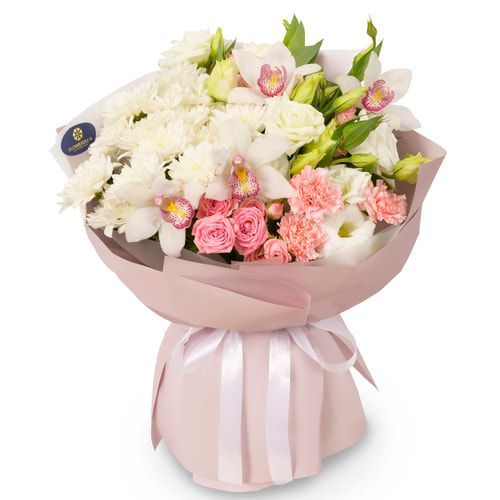Strelitzia: secrets of care and cultivation at home
Strelitzia, or a bird of paradise, is one of the most unusual herbaceous perennials in the world. The plant is native to Madagascar and Zimbabwe. Strelitzia received its name in honor of the wife of King George III, Princess of Mecklenburg, Charlotte-Sophia of Mecklenburg-Strelitz. The queen was removed from public affairs, but all her life she patronized the sciences and the Royal Botanic Gardens in London. The plant has a very beautiful flower, unusual fruit and stem shape. If you decide to grow exotic strelitzia at home, hurry up to place an order for flowers in Kyiv. The Flowers.ua managers process client requests instantly.
Strelitzia in Detail

Strelitzia looks most beautiful during flowering. The orange-colored flower resembles the body of an exotic bird, and the green leaves look like wings. You can also find strelitzia with blue and purple inflorescences. The roots of the plant are pivotal and go deep into the ground. The bud is collected in a bunch, which can be mistaken for a beak from afar. The leaves are leathery, oval in shape, with a slight blue bloom; their length can reach 200 cm (6.6 ft.). There are up to 10 honey-bearing flowers in one bud.
The flowering lasts up to six months under natural conditions. If strelitzia is cut and placed in a vase, it doesn’t fade for up to a month. With proper care for indoor strelitzia, it will delight you with its flowering for a long time. In the open ground, the plant is able to survive only in its homeland, Africa. In the Eastern European latitudes, florists grow strelitzia at home or in the indoor greenhouses. Despite the fact that the plant is quite large, it grows only up to 1.5 m (4.9 ft.) in a room. Some grow strelitzia in a closed florarium, but for this it requires suitable neighbors and the correct temperature.
Strelitzia Types
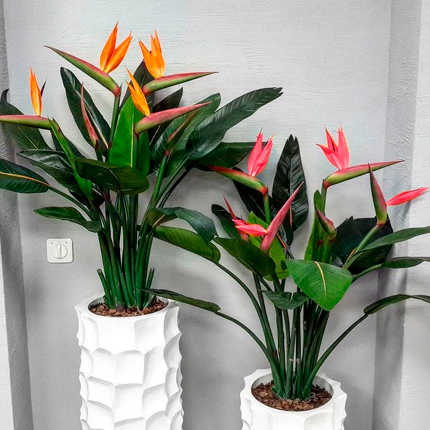
Strelitzia is an evergreen herbaceous perennial. In total, there are 5 types of strelitzia in the world (royal, mountain, reed, white, and nicolai). Only two of them are considered indoor species: royal and nicolai. Many experienced and novice florists want to grow strelitzia at home because of its incredible decorative properties. Despite its tropical origin, the plant takes root quite well indoors.
Royal Strelitzia
The very first species of strelitzia known to science was brought to Europe by the English scientist and botanist Francis Masson in 1773. Since then, the plant has gained immense popularity in Western Europe, and in the United States, strelitzia was made the official symbol of the City of Los Angeles in 1953. If grown in a pot and planted within the city, it reaches 1 m (3.3 ft.) in length and is tolerant of polluted air and lack of watering. The flowers are oval, up to 40 cm (1.3 ft.) long, with a hard spine. The rhizome is very strong and powerful; you can even propagate the flower with its help.
Inflorescences with brown bracts and bright orange petals look like certain flowering cacti. The flowers may not fade for more than a month, and with proper care they will bloom constantly. The plant also responds well to periodic pruning.
Strelitzia Nicolai
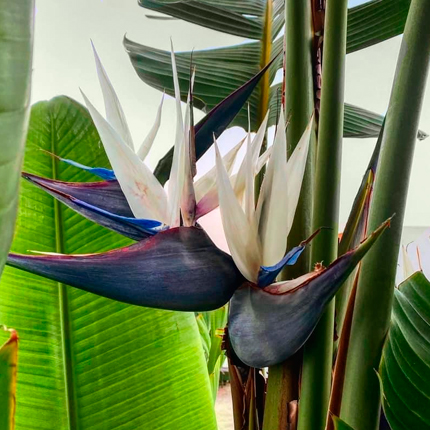
The variety is named after the Russian Emperor Nicholas I, who in the 19th century was the curator of the Saint Petersburg Botanical Garden. In its natural environment, this plant can reach 6 m (19.7 ft.) in length. It grows well in gorges, tropical forests, and mountainous areas. It is most widely distributed in South Africa, in the Cape Province. The plant is so similar to a banana that the locals call it the “Natal wild banana”. The leaves are very large, shiny, and green. Strelitzia nicolai is not suitable for indoor conditions due to its huge size, which it reaches due to the long period of growth. The trunk is covered with scars from fallen leaves.
Mountain Strelitzia
This huge tropical plant can safely claim the laurels of large tropical trees. Mountain strelitzia grows up to 10 m (32.8 ft.) in length, and its trunk is bare, which makes the perennial look like a palm or banana tree. The white flowers are very large (up to 45 cm / 1.5 ft.) and resemble a boat in their shape. The bracts are red, and the inner flowers are blue; the fused corollas are covered with stipules. This is a very rare tree-like species.
White Strelitzia
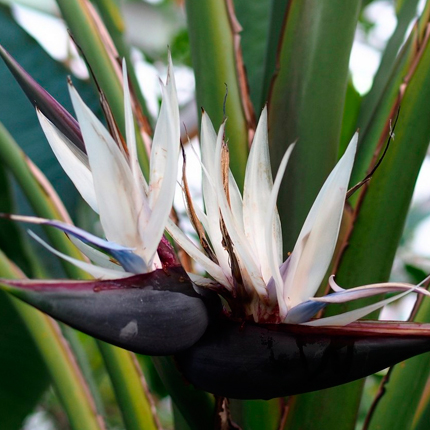
A beautiful perennial, which is also called Strelitzia augusta. The leaves reach 1 m (3.3.ft.) in length and have the shape of an ellipse. The plant has axillary peduncles and hidden lanceolate bracts. The petals are white; the flowering lasts from May to July. When the petals wither, they release a special box in which the seeds are stored. The stamen filaments are small, only up to 3 cm (0.1 ft.); together with the anthers, they are up to 5.5 cm (0.2 ft.). Unfortunately, the species is on the verge of extinction and is listed in the Red Data Book of African Plants. Florists also developed a hybrid of royal and white strelitzia.
Reed Strelitzia (Strelitzia juncea)
It grows in the east of South Africa, but differs greatly from its relatives in its appearance. Reed strelitzia tolerates cold, drought, and temperature extremes well. The orange flowers strongly resemble royal strelitzia outwardly, but they cannot be confused. The needle-like leaves with a wax coating grow up to 2 m (6.6 ft.) in length and are devoid of leaf blades. This tropical beauty is also on the verge of extinction due to its huge popularity in the world. Professional flower growers are now trying to preserve the species and are engaged in artificial breeding and pollination of the plant.
Strelitzia Propagation
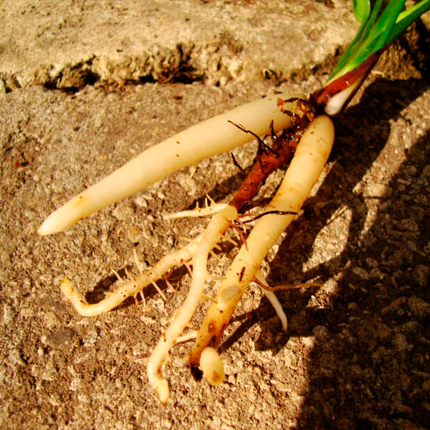
Many “bird of paradise” species are on the verge of extinction, and strelitzia is not easy to find in flower shops. That is why the propagation skills will always come in handy. You can get your own tropical exotic plant both by sowing seeds and by vegetative division. All types of the plant are not very well suited for keeping in an ordinary apartment due to their large size, but this doesn’t bother the flower growers. Before buying seeds, it is very important to look at the collection date and make sure they are in good condition. The purchased seeds are often not suitable for planting, and they can also get damaged during shipping. Only reed strelitzia doesn’t reproduce by shrub crushing, but you can try propagating it by division. Strelitzia, like other tropical flowering houseplants, reproduces best in conditions close to natural.
Growing From Seeds
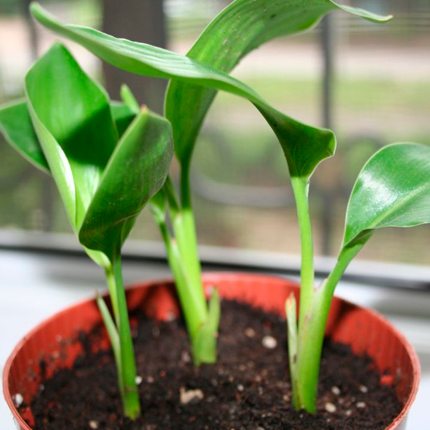
Before buying seeds, look at how much time has passed since they were packed. If they are older than 6 months, the shoots may not appear. It is better to buy seeds in large stores and carefully inspect them. It is advisable not to consider wet, dirty, and heterogeneous specimens so as not to waste your money. Strelitzia can be planted at any time of the year; the main focus will be on observing the temperature and the necessary conditions. Special soil and a greenhouse are required for planting in the open ground, as temperatures below 10°C (50°F) are detrimental to the plant. The greenhouse must constantly maintain high humidity, a temperature of at least 22°C (71.6°F), and 12-hour lighting. The best planting time in a greenhouse is the end of May. When it’s warm outside, the greenhouse can be opened to let strelitzia “breathe”.
Seed Preparation
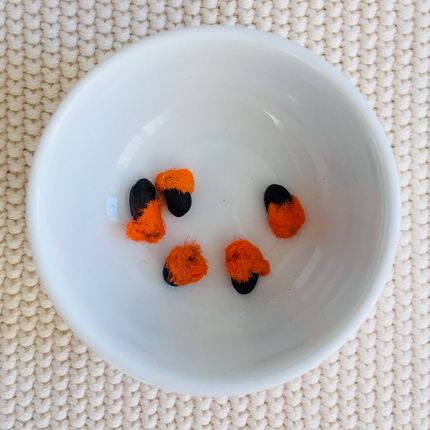
Seeds must be prepared for planting and soaked for two days in warm water to stimulate their activity. After they swell, remove the fruit remains from them. Confident and experienced flower growers can try special phytohormones. It is necessary to use such additives only after carefully reading the instructions and preferably consulting with specialists. Special phytohormones for strelitzia are best suited for the job. However, keep in mind that both methods don’t guarantee 100% seed germination.
Soil Preparation
It is better to purchase the soil in specialized stores, but you can prepare it yourself. For this, you will need peat, compost, and sand. Mix all the ingredients in a ratio of 1:1:1, 500 g (17.6 oz.) of each ingredient. For greater nutritional value, you can add a little peat humus – and don’t forget about drainage.
Strelitzia Pot
You can make a container for strelitzia yourself, but purchased pots are also great. Choose a small pot in the store, from 200 to 300 ml (6.8-10 oz.). The main condition is a drainage hole; otherwise the water will stagnate and the roots will rot. Strelitzia can be safely planted in an ordinary plastic cup. Fill it ⅔ full with substrate and make a few holes in the bottom for water to drain. You will need a big pot to grow a mature plant, as strelitzia is very large and unlikely to fit in a typical apartment without special conditions.
Planting
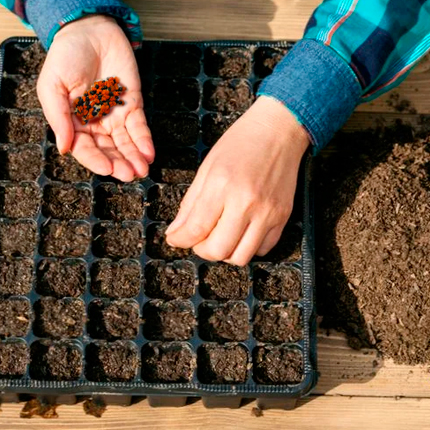
Before sowing, it is necessary to moisten the soil with boiling water. Pour the substrate over and wait until the water flows out through the holes or is absorbed in the drain. Then wait until the soil cools down a bit and pour a thin (no more than 2 cm / 0.1 ft.) layer of sand on top. Seeds must be planted into this layer of sand. If you are not sure about the quality of planting material, you can plant up to 3 seeds in one container. Warm and nutritious soil will be ideal for strelitzia. When all is done, you have to be patient; the first shoots usually appear after 3-5 months, but there have been cases of active growth even 9 months after planting. If the material is of poor quality or the soil was prepared incorrectly, seedlings may not appear at all. After the seeds have been planted, the container is covered with glass or polyethylene and placed in a well-lit place with diffused light. It is necessary to cover the plant so that the fungus and other bacteria don’t get into the nutrient medium.
Seedling Сare and Transplanting
After germination, the plant is transferred into a larger pot, but before that, the soil must be moistened frequently and abundantly. Strelitzia should be watered with warm, settled water. There is no need to top dress it before transplanting, since at this stage the plant receives everything it needs from the substrate. The “bird of paradise” is transplanted into larger containers with a margin so that when the plant grows up, it doesn’t rest against the walls. If strelitzia grows well, it needs to be transplanted once a year. When doing this, try to carefully handle the root system, as it is very fragile despite its apparent strength. The windowsills facing east and west are the perfect place for this exotic beauty. The first flowering can be expected in several years.
Vegetative Propagation
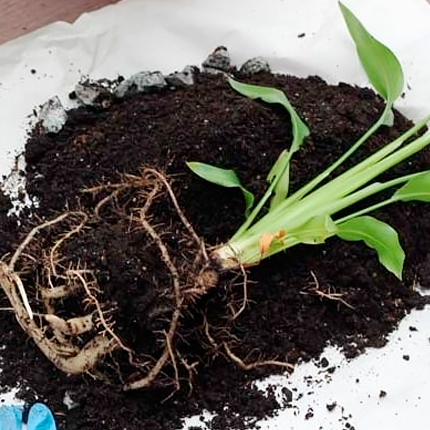
Strelitzia is also propagated by dividing the root and shoots. Once flowering is complete, it is the ideal time to propagate by dividing the root. The main condition is to prepare spacious pots with a good drainage system. The part to be divided must be healthy and at least 20 cm (0.7 ft.) long. The substrate needed is exactly the same as for propagation by seeds.
To propagate by lateral shoots, pull the mature strelitzia out of the ground along with the earthy clod and carefully clean the roots. Cut off the diseased or withered parts, select the healthiest shoot, separate it, and treat the cut points of both the mother plant and the derivative plant with a fungicide or charcoal. It is desirable that the root has several shoots. Transfer part of the plant into a separate pot and store at a temperature not lower than 22°C (71.6°F). A good plant’s age to start the vegetative propagation is 6-7 years.
Strelitzia Care
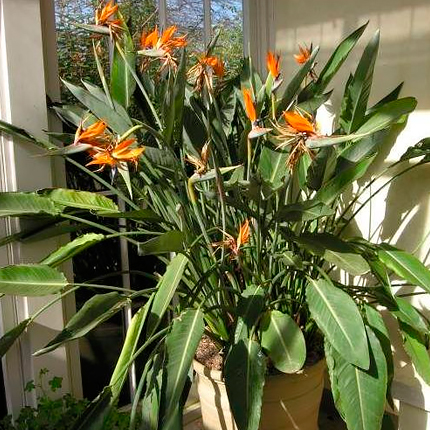
The plant is not too difficult to grow at home, but a few basic rules are best to be remembered. It needs diffused sunlight, so east-facing windows are best suited for it. When transferring to another spot, make sure that the direction of the light is similar to the previous one. No need to rotate the pot to find the light for the “shadow side”. This will only aggravate the situation and may lead to curling leaves. Strelitzia not only handles the difference between the night and day temperatures well, but also accelerates its growth because of this. In winter, you need to insulate the pot with foam, or shelter it from the cold if the room is poorly heated. Direct sunlight can damage the plant, as can strong winds. Water strelitzia sparingly, but often enough so that the substrate doesn’t have time to dry out. Periodic warm showers will remind it of the warm tropical monsoons and will not harm the plant in any way. The frequency of watering can be slightly reduced in winter, and the humidity can be left unchanged. Never leave the shrub near the heater. In the morning, you can wipe the dust from the leaves and additionally moisten them with a little spraying so that they are dry in the evening.
Once every 10 days, strelitzia is fed with organic and inorganic supplements. During winter and dormancy, the top dressing is ceased, and the temperature close to the tropical winter is provided for the plant. After withering, the peduncle must be removed by hand to stimulate the appearance of new buds – naturally, if you are not going to pollinate the plant yourself. There should be a lot of light after removal, and you should sustain relative coolness indoors (not lower than 12°C / 53.6°F). In Eastern European latitudes, strelitzia will certainly need artificial lighting in winter, for example, fluorescent lamps. In its natural habitat, the plant receives light 12 hours a day, and with the lighting frequency of 6-7 hours, strelitzia will suffer and may even die. If you want the beautiful flowers quicker, but they still don’t appear, a slight shake can help. Reduce watering while decreasing the amount of light, or try a radical change of scenery and move strelitzia to another window. This is only necessary if you are sure that the plant is completely healthy.
Pests and Diseases
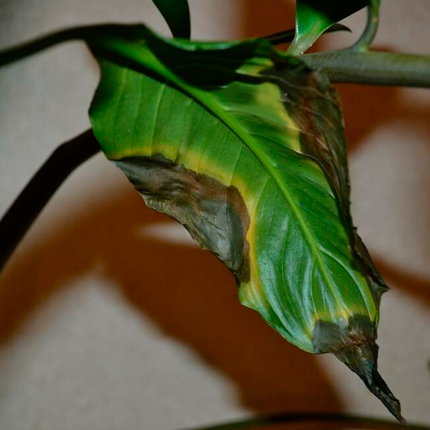
Bird of paradise is a fairly hardy plant and is not prone to disease, but certain pests or improper care can lead to undesirable consequences. The main enemy of strelitzia, like many other ornamental plants, is the spider mite. Its presence can be seen with the naked eye: cobwebs appear on the leaves, and they look unhealthy and pale. Also on the list of enemies are scale insects and mealybugs. All flower growers are advised to deal with them with acaricidal agents. If the leaves are covered with a layer of sticky white mucus, this is a sign of scab infestation. However, you can quickly get rid of it with a sponge, "Aktara", and a solution of laundry soap.
White spots on the leaves are a sure sign of thrips. In this case, remove the diseased and affected leaves, carefully wipe the healthy ones, and treat the entire plant with an insecticide. Treat the leaves with "Aktara" and repeat the procedure after 2-3 weeks. Too concentrated a solution will only hurt, so carefully follow the instructions on the package. If you water the plant too often or install poor drainage, the roots will rot and a characteristic smell will appear.
Yellowed foliage is a signal of low indoor temperature, lack of light and fertilizer. If the plant is growing too slowly, check the pot, as your favorite strelitzia may just be cramped.
If the leaf edges often dry up, this means that the room is too dry. Place a humidifier near the shrub or remove excess heat sources from the room. Darkening of the roots is also possible, which can be caused by a fungus. In this case, adjust the watering regime: the colder it is outside, the less you should water the plant. You can try to avoid giving strelitzia inorganic fertilizers for a while. During the flower bud formation, don’t move the plant away from a fixed light source. This can lead to the bud’s death, which then will have to be removed by hand.
